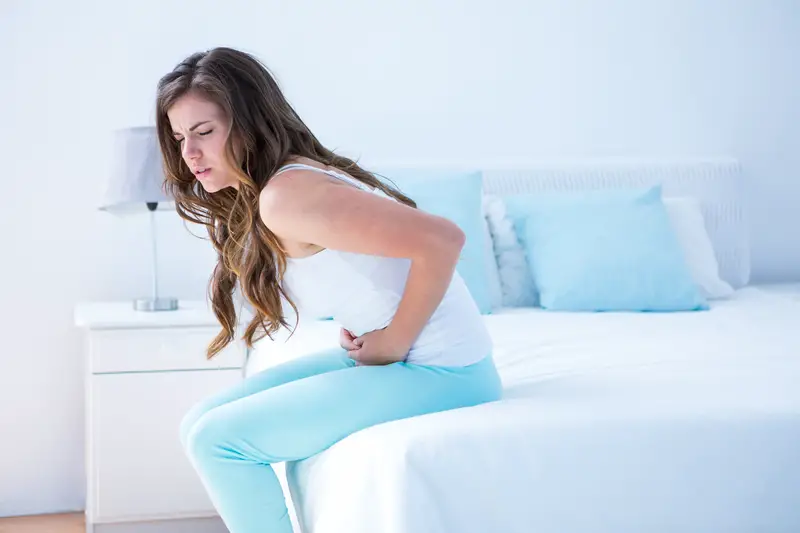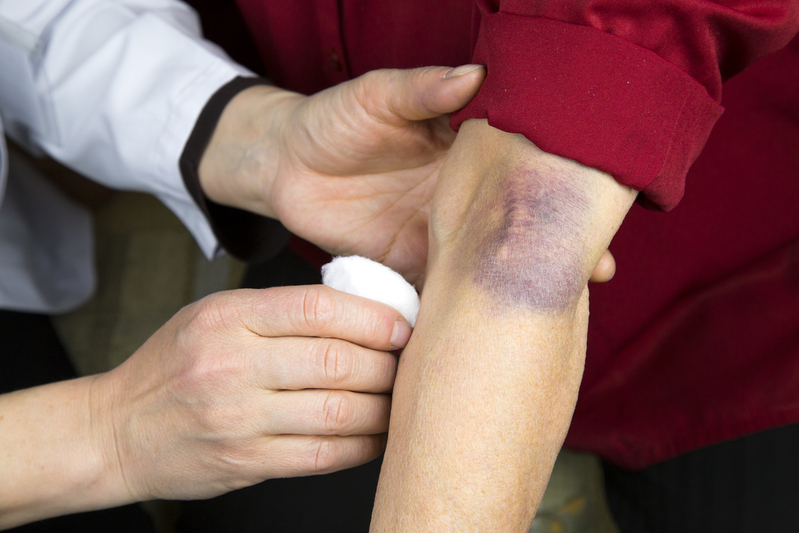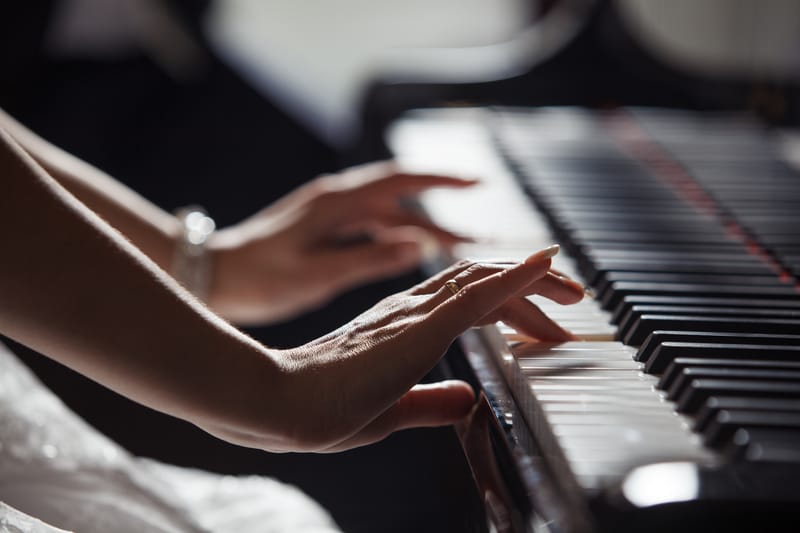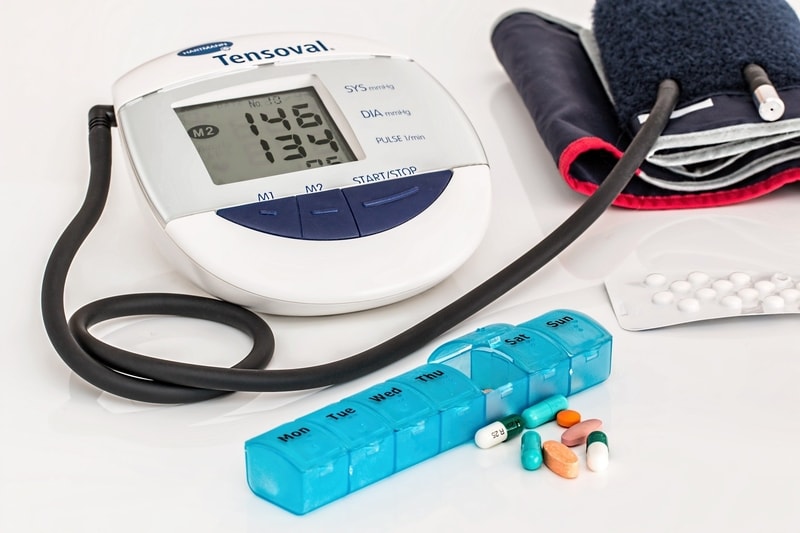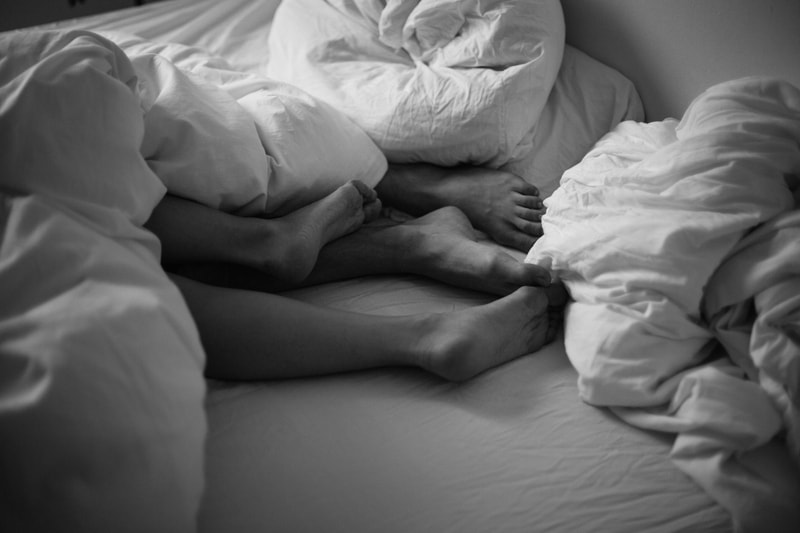Believe it or not, offices can be bad for your body’s health and well-being. Sitting in a chair all day in front of a computer screen can lead to health issues like back pain, stress, colds, eye strain, frequent headaches, anxiety, depression, and fatigue. Office spaces can contain up to 400 times as many microbes as a bathroom. This puts office workers at higher risks of not only injuries to the neck and lower back, but also colds, flu, and pathogens. Using acupressure on these six amazing acupoints can alleviate and even eliminate these issues, particularly the GV 16 acupuncture point.
1. Acupoint: GV-16 (Other Names: The Governing Vessel-16/Feng Fu/Wind Palace)
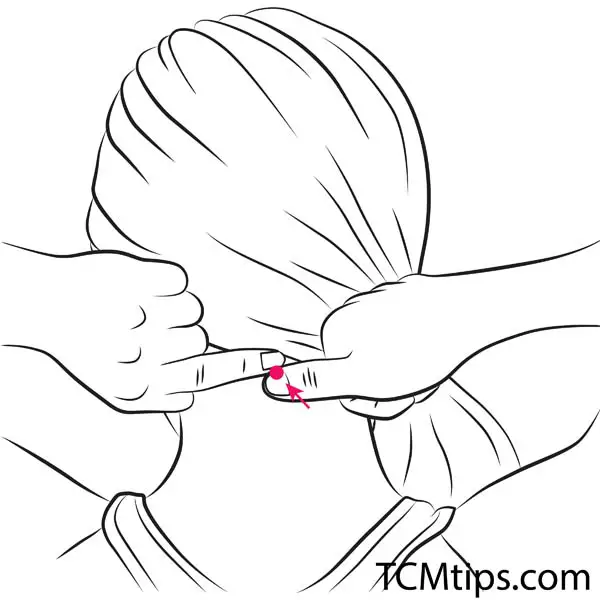 The GV 16 acupuncture point can be used to correct for office-related health issues. If you suffer from headaches, a stiff neck, blurry vision, hypertension, and anxiety or sadness, you should target the feng fu point using acupressure.
The GV 16 acupuncture point can be used to correct for office-related health issues. If you suffer from headaches, a stiff neck, blurry vision, hypertension, and anxiety or sadness, you should target the feng fu point using acupressure.
The feng fu point is located along the midline, at the nape of the neck in the hollow below your skull. To find it, trace your finger up the middle of the back of your neck and feel for the bump of the skull that sticks out. The feng fu point is right below that bump.
You can press firmly with either your knuckles, thumbs, or two fingers on the acupoint for a minimum of 3 minutes to apply pressure. Another option for more extended treatment is to lay on a flat surface, face up with a tennis ball directly on that point. The tennis ball will relieve the tension, stiffness, and pain in your neck and head, but do not do this for too long as it may start to hurt. Lastly, you can have someone else press on the feng fu acupoint while you are lying face down. This is often more relaxing than doing it yourself.
The amount of pressure should be firm enough that it hurts just a little. However, the weaker your neck muscles, the less pressure you should apply. If your neck is very sensitive or in pain, you can build up the pressure until you are comfortable with more pressure. You should not be in excruciating pain, as this is counterproductive.
2. Acupoint: Bl-1 (Other Names: Urinary Bladder-1/Jing Ming/Bright Eyes)
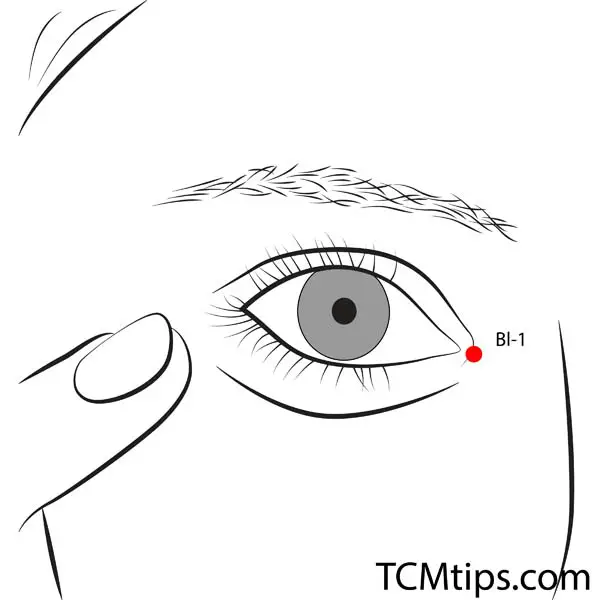
For office workers who experience blurred vision, redness, swelling, dizziness, insomnia, eye fatigue, and lumbar pain, you should use acupressure on the Jing Ming (Bl-1) point.
The Jing Ming acupoint is located on the face, in the depression of the eye socket, just slightly above the inside corner (canthus) of the eye. To locate it, use the tip of your index finger to trace along the bridge of your nose, locate the canthus, and press directly above it.
Use your index fingers’ tips to apply pressure to the Jing Ming point for one to two minutes. Whichever eye is experiencing more pain or problems, focus the pressure on that side. The pressure should be firm but not painful. You can build up the amount of pressure you apply until it is comfortable and relaxing.
3. Acupoint: LI-11 (Other Names: Large Intestine-11/Qu Chi/Pool at the Crook)
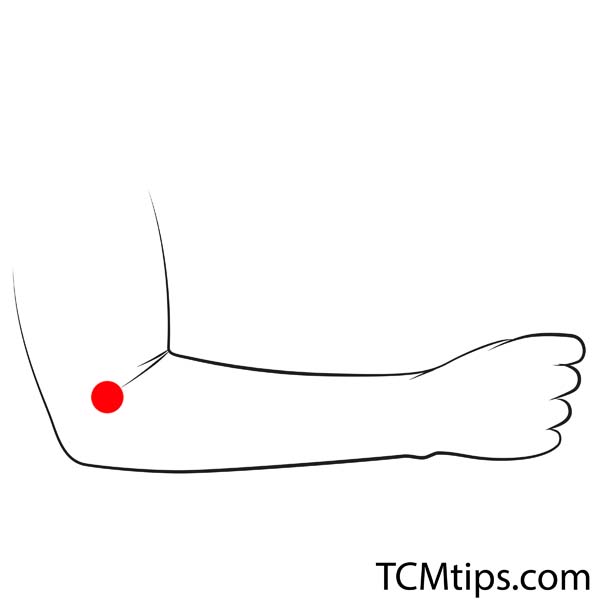
Fatigued office workers have a weakened immune system, and in an environment full of bacteria as an office, workers are more susceptible to colds, illnesses, and pathogens. The Quchi (LI 11) acupoint is one of the best, most powerful points at “releasing the exterior”. It’s known to expel outside wind, clear heat, and cool the blood. In other words, this acupoint helps pass colds, fevers, and pathogens through our body quicker by “opening the door” for them to pass through.
The Quchi point is located near the elbow. To find it, bend your arm with your thumb pointing up, and find the crease on the outside of your arm. The LI 11 is right where the elbow crease ends.
Bring your hand up toward your chest, with the thumb pointing up. Use your other thumb to apply deep, firm pressure to the Quichi point. You should move your thumb in a counter-clockwise, circular motion. Do this for about three minutes every day. You can apply acupressure five times a day to kickstart the body’s healing powers for more results.
4. Acupoint: Liv-3 (Other Names: Liver-3/Tai Chong/Supreme Rush)
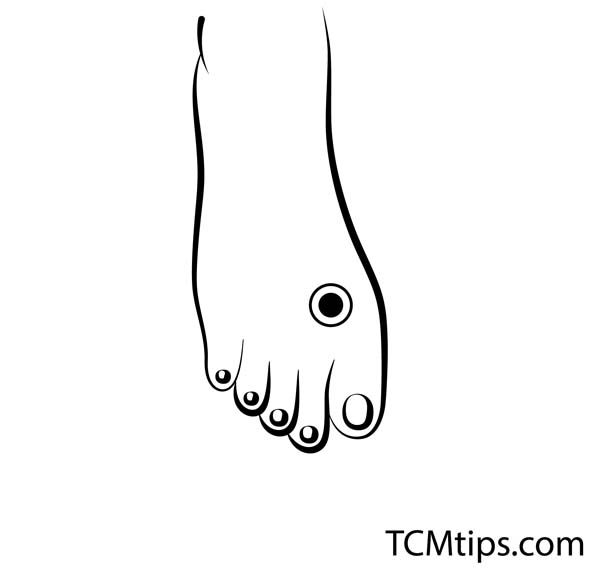
Indicators that you should use the Taichong acupoint (Liv-3) are bloating, nausea, constipation, irregular menstruation, blurry vision, and headaches. Office workers who experience irritability, anger, insomnia, backaches, dizziness, and swelling should apply pressure to acupoint Liv-3. It can help bring clarity, focus, and energy to a fatigued person.
The Taichong point is located on the top of the foot, in the dip where the big toe connects to the second toe. To find the acupoint, trace your thumb down the top of your foot, and let it rest in the dip between the big toe and second toe.
To stimulate the Taichong point, sit down and bring your foot up to you by resting your left leg on top of the right thigh. Apply gentle pressure with your thumb to the Liv-3 acupoint for at least two minutes. Repeat this for the other foot. For more significant results and relief, you can perform acupressure on this point up to three times a day.
5. Acupoint: GB-21 (Other Names: Gallbladder-21/Jian Jing/Shoulder Well)
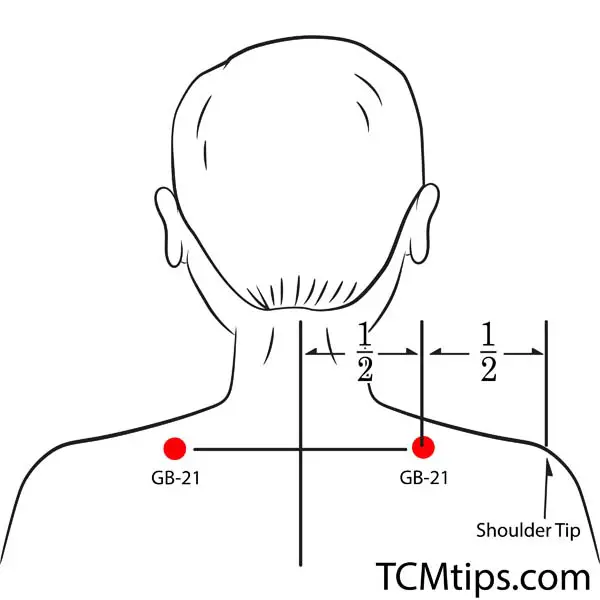
The GB 21 point is most commonly used for physical issues like neck pain, stiffness, shoulder tension, muscle spasms, and chronic headaches. Additionally, it can settle nerves, feelings of irritability and calm a person overall.
The Jian Jing point is located on the shoulder, halfway between the rotator cuff and the spine. To find it, pinch the top of the shoulder with your thumb and middle finger. The point is located between these two fingers. Pregnant women should not use this point since it may induce labor.
To stimulate GB 21, use your thumb or two fingers to apply firm pressure for five seconds. Release, rest for a few seconds, then repeat. You may repeat this as many times as needed throughout the day. The Jian Jing point is better targeted by another person since they can better reach the acupoint and apply pressure as needed.
6. Acupoint: GB-30 (Other Names: Gallbladder-30/Huan Tiao/Jumping Circle)
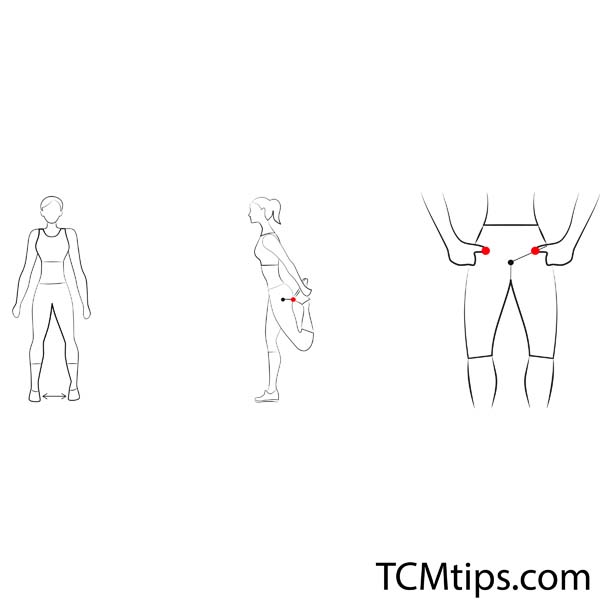
The GB 30 point is the best acupressure treatment for relieving sciatic, lumbar, and hip pain. Office workers who sit for hours on end are likely to experience these pains. Indicators for this acupoint are a pain in your lower back, hips, sciatic, legs, and knees.
The Huan Tiao point is located deep in the gluteus maximus. At the junction of the lateral 1/3 and medial 2/3 of the distance between the great trochanter and the sacrum’s hiatus. Alternatively, you can also bend your leg as shown in the diagram above. Your heel will be touching the acupoint directly.
To target the Huan Tiao acupoint, lay on a flat surface facing downward. Have another person use their palm to locate the point and apply deep, firm pressure in a circular, counter-clockwise motion for one to two minutes. For even deeper pressure, they can use their elbow to press into GB 30 for several seconds at a time. They should only use their elbow if you can tolerate that level of pressure. There should be some pain, but not excruciating.
Related Reading
Credit: Photo by Ant Rozetsky on Unsplash

Try our Anti-Aging Gua Sha Tool designed to bring out your skin’s natural glow.
Best Gua Sha Product- Anti-Aging: The tool is designed to target 11 specific aging signs such as wrinkles and sagging skin. By following the 7-step routine, users can improve skin firmness and reduce fine lines naturally.
- Enhances Skincare Routine: It works effectively with serums and lotions, boosting absorption and efficacy of skincare products.
- Visible Skin Improvement: Users can expect a smoother complexion, reduced puffiness, and a more youthful appearance.
 P. Sze
P. Sze 












